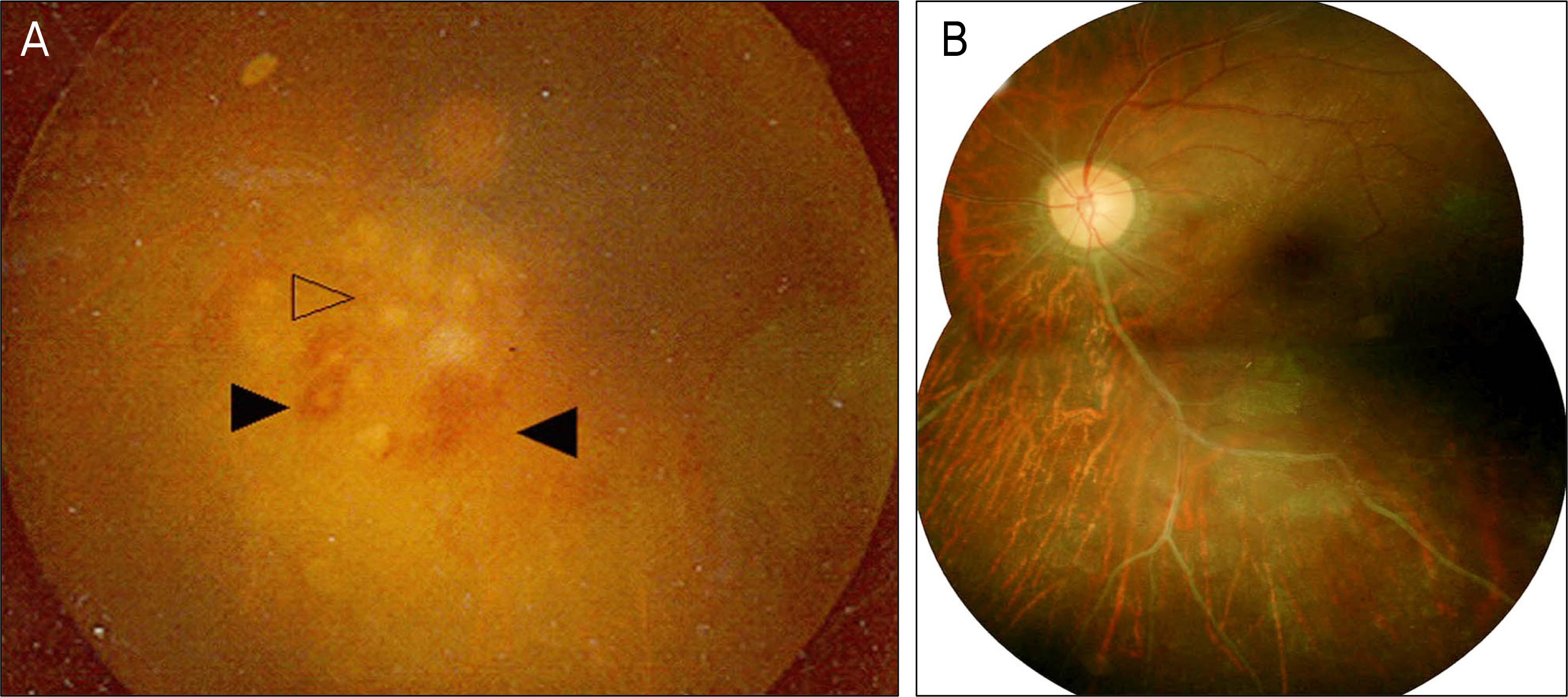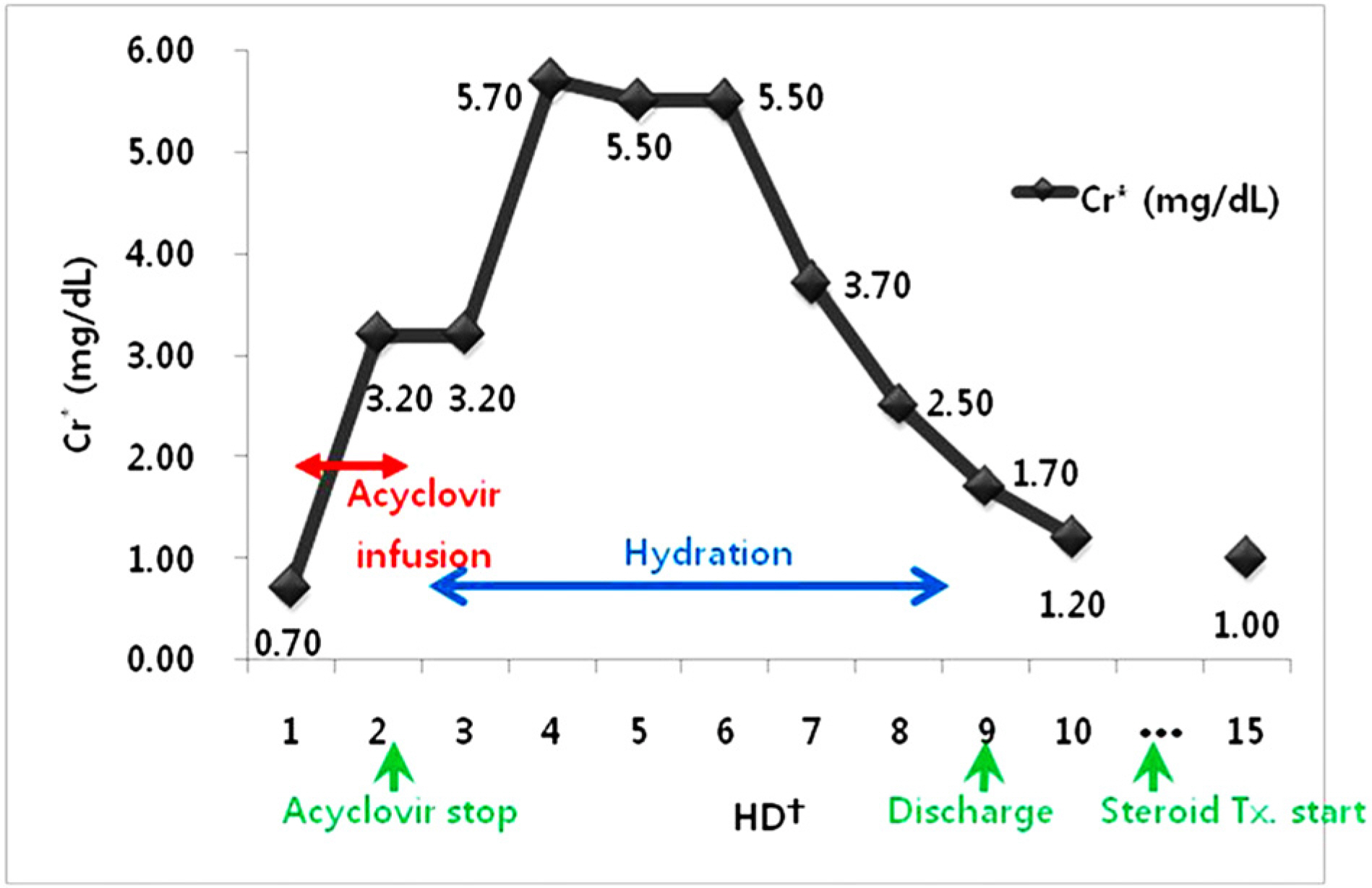J Korean Ophthalmol Soc.
2010 Nov;51(11):1528-1531. 10.3341/jkos.2010.51.11.1528.
Acyclovir-induced Acute Renal Failure in a Patient With Suspected Acute Retinal Necrosis Syndrome
- Affiliations
-
- 1Department of Ophthalmology, Kangnam Sacred Heart Hospital, Hallym University College of Medicine, Seoul, Korea. ophkim@hallym.or.kr
- 2Department of Internal Medicine, Kangnam Sacred Heart Hospital, Hallym University College of Medicine, Seoul, Korea.
- KMID: 2213991
- DOI: http://doi.org/10.3341/jkos.2010.51.11.1528
Abstract
- PURPOSE
To report a case of acyclovir-induced acute renal failure (ARF) suspected as acute retinal necrosis syndrome.
CASE SUMMARY
The authors report a 55-year-old male patient who presented with left eye visual disturbance due to suspected acute retinal necrosis syndrome. Non-oliguric ARF developed after the infusion of intravenous acyclovir (850 mg every 8 hours). The patient did not show any uremic symptoms or signs. The crystal was not discovered in the urine. After stopping the acyclovir infusion and hydration, acyclovir-induced ARF was reversed.
CONCLUSIONS
Although possessing critical nephrotoxicity, acyclovir is a useful antiviral drug. Therefore, when using acyclovir, the importance of hydration and preventing acyclovir-induced ARF should be considered.
MeSH Terms
Figure
Reference
-
References
1. Clarkson JG, Blumenkranz MS, Culbertson WW, et al. Retinal detachment following the acute retinal necrosis syndrome. Ophthalmology. 1984; 91:1665–8.
Article2. Freeman WR, Thomas EL, Rao NA, et al. Demonstration of herpes group virus in acute retinal necrosis syndrome. Am J Ophthalmol. 1986; 102:701–9.
Article3. de Boer JH, Verhagen C, Bruinenberg M, et al. Serologic and polymerase chain reaction analysis of intraocular fluids in the diagnosis of infectious uveitis. Am J Ophthalmol. 1996; 121:650–8.
Article4. Usui Y, Goto H. Overview and diagnosis of acute retinal necrosis syndrome. Semin Ophthalmol. 2008; 23:275–83.
Article5. Matsuo T. Vitrectomy and silicone oil tamponade as an initial surgery for retinal detachment after acute retinal necrosis syndrome. Ocul Immunol Inflamm. 2005; 13:91–4.6. McDonald HR, Lewis H, Kreiger AE, et al. Surgical management of retinal detachment associated with the acute retinal necrosis syndrome. Br J Ophthalmol. 1991; 75:455–8.
Article7. Sawyer MH, Webb DE, Balow JE, Straus SE. Acyclovir-induced renal failure. Clinical course and histology. Am J Med. 1988; 84:1067–71.8. Holland GN. Standard diagnostic criteria for the acute retinal necrosis syndrome. Executive Committee of the American Uveitis Society. Am J Ophthalmol. 1994; 117:663–7.9. Kim SJ, Yu HG. Bilateral acute retinal necrosis syndrome in the patient with acquired immunodeficiency syndrome. J Korean Ophthalmol Soc. 2003; 44:2445–50.10. Duker JS, Blumenkranz MS. Diagnosis and management of the acute retinal necrosis (ARN) syndrome. Surv Ophthalmol. 1991; 35:327–43.
Article11. Tam PM, Hooper CY, Lightman S. Antiviral selection in the management of acute retinal necrosis. Clin Ophthalmol. 2010; 4:11–20.12. Chang S, Young LH. Acute retinal necrosis: an overview. Int Ophthalmol Clin. 2007; 47:145–54.
Article13. Criteria for diagnosis of Behçet's disease. International Study Group for Behçet's Disease. Lancet. 1990; 335:1078–80.14. Biswas J, Sharma T, Gopal L, et al. Eales disease an update. Surv Ophthalmol. 2002; 47:197–214.15. Markowitz GS, Perazella MA. Drug-induced renal failure: a focus on tubulointerstitial disease. Clin Chim Acta. 2005; 351:31–47.
Article16. Keeney RE, Kirk LE, Bridgen D. Acyclovir tolerance in humans. Am J Med. 1982; 73:176–81.
Article17. Tucker WE Jr, Macklin AW, Szot RJ, et al. Toxicology studies with acyclovir: acute and subchronic tests. Fundam Appl Toxicol. 1983; 3:573–8.18. Bean B, Aeppli D. Adverse effects of highdose intravenous acyclovir in ambulatory patients with acute herpes zoster. J Infect Dis. 1985; 151:362–5.
Article19. Izzedine H, Launay-Vacher V, Deray G. Antiviral drug-induced nephrotoxicity. Am J Kidney Dis. 2005; 45:804–17.
Article20. Rashed A, Azadeh B, Abu Romeh SH. Acyclovir-induced acute tubulointerstitial nephritis. Nephron. 1990; 56:436–8.
Article21. Perazella MA. Crystal-induced acute renal failure. Am J Med. 1999; 106:459–65.
Article22. Pérez-Blázquez E, Traspas R, Méndez Marín I, Montero M. Intravitreal ganciclovir treatment in progressive outer retinal necrosis. Am J Ophthalmol. 1997; 124:418–21.
Article
- Full Text Links
- Actions
-
Cited
- CITED
-
- Close
- Share
- Similar articles
-
- Bilateral Acute Retinal Necrosis Syndrome in the Patient with Acquired Immunodeficiency Syndrome
- Treatment of Acute Retinal Necrosis with Intravenous Acyclovir
- Two Cases of Acute Retinal Necrosis Treated With Systemic Antiviral Drugs and Intravitreal Antiviral Injections
- Acute Retinal Necrosis Syndrome in an Immunosuppressed Kidney Transplant Patient
- Early surgical management in bilateral acute retinal necrosis




